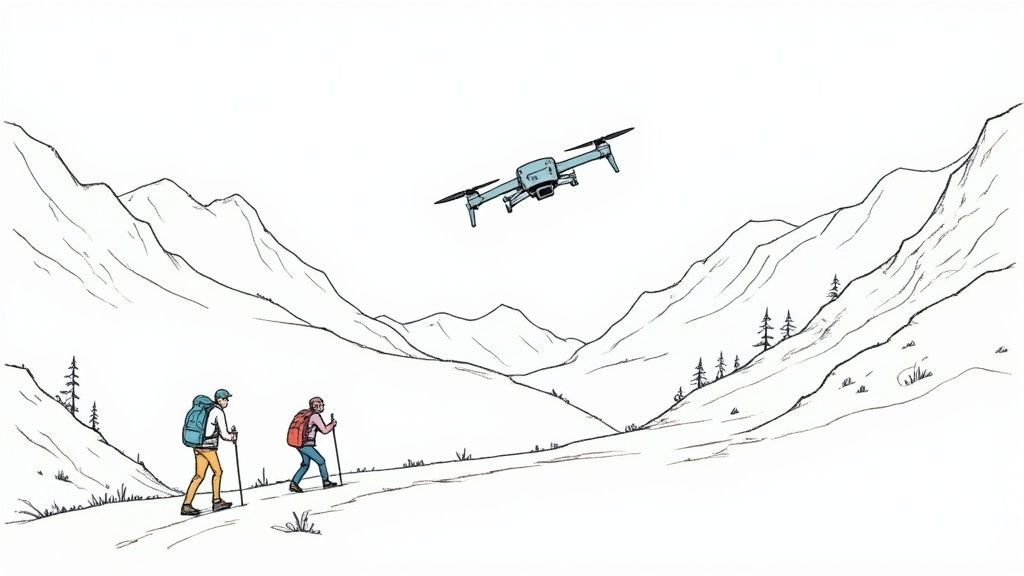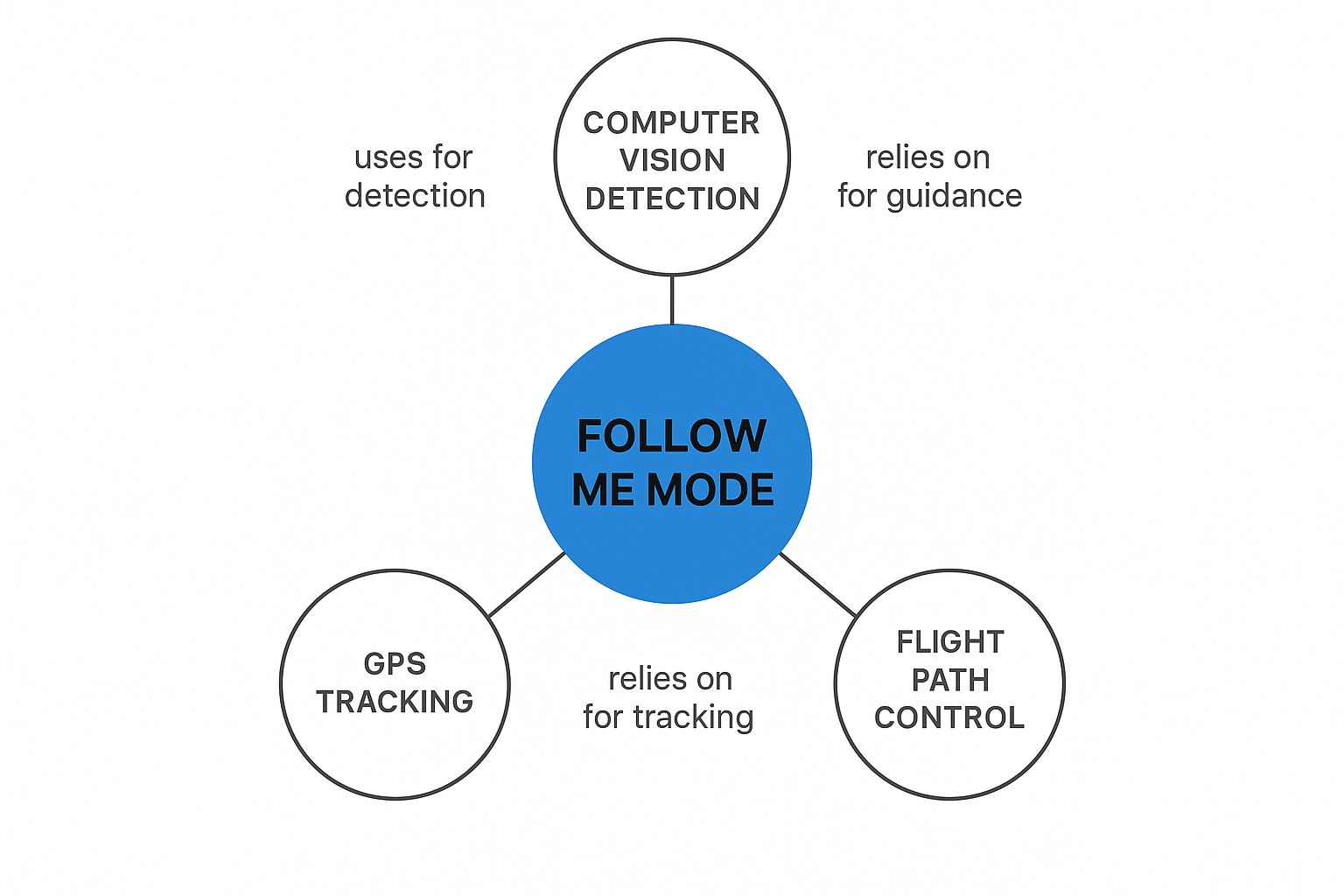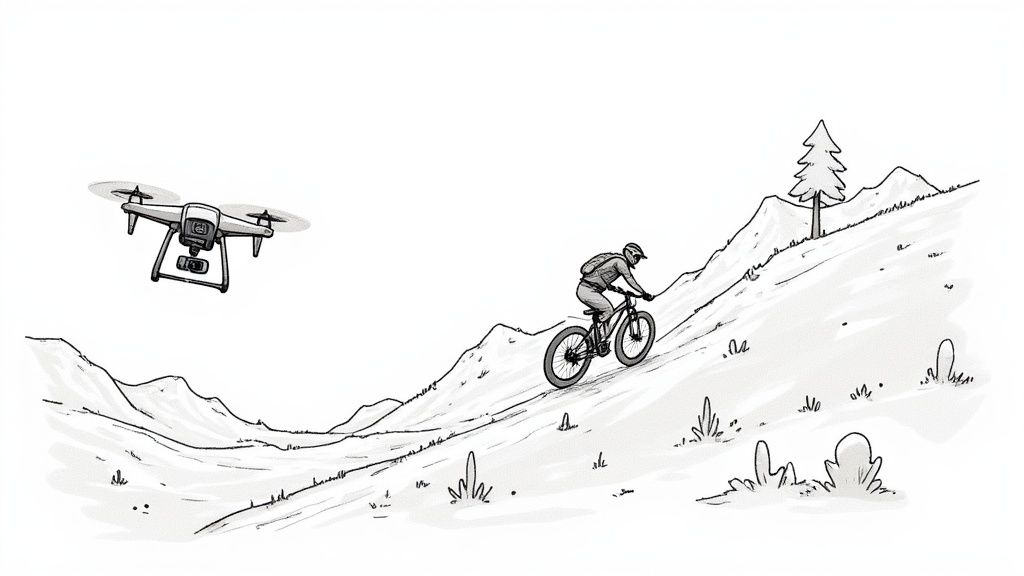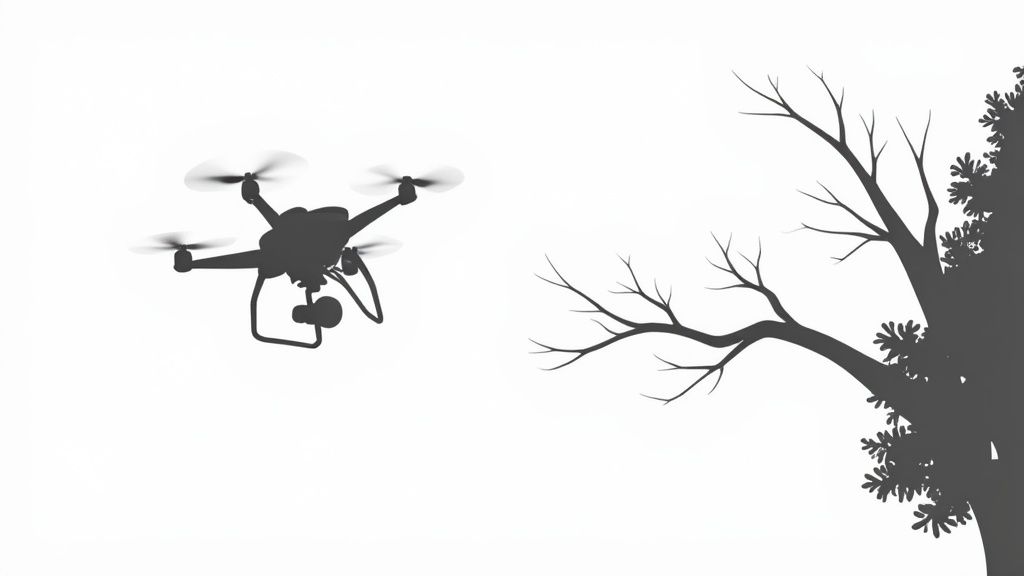Your Guide to Follow Me Mode Drone Filming
- James Baptiste

- Jul 27
- 13 min read
Updated: Jul 28
Ever feel like you need your own personal camera crew to capture your adventures? That's pretty much what a follow me mode drone gives you. It acts like a smart, airborne camera operator that automatically tracks and films you while you're on the move. This hands-free feature is an absolute game-changer for getting those epic action shots without needing someone else behind the controls.
What Is Follow Me Mode on a Drone?

Picture this: you're mountain biking down a twisting trail or kayaking along a beautiful river. Trying to film yourself is out of the question, and getting a friend to pilot a drone smoothly enough to keep up takes serious skill. This is exactly the problem Follow Me Mode was designed to solve.
It’s an intelligent flight mode that lets you tell the drone to lock onto a subject—usually you—and then follow it autonomously, keeping the camera perfectly aimed at the action.
Think of it as putting your drone on autopilot with a single mission: keep you in the frame, no matter what. This capability has completely transformed how solo creators, athletes, and adventurers capture their experiences. Suddenly, you don't need a dedicated camera crew to get professional-looking, dynamic aerial footage. You just set the subject, launch the drone, and go.
How Does It All Work?
This incredible feature isn't magic, though it can feel like it. It's actually a clever combination of hardware and software working together seamlessly. From a high level, the drone uses a few different technologies to keep tabs on its subject. The two main methods you'll find are:
GPS Tracking: This is one of the most common methods. The drone simply follows the GPS signal coming from your remote controller or a connected smartphone. It’s programmed to maintain a set distance and orientation from that signal as it moves.
Vision Recognition: A more advanced approach, this uses the drone's camera and sophisticated AI algorithms. The drone visually identifies and "remembers" a subject—like a person, a car, or even a boat—and then tracks it based on what it sees.
To give you a clearer picture, here’s a quick breakdown of the technologies that make this possible.
Follow Me Technology at a Glance
Technology Type | Best For | |
|---|---|---|
GPS | Follows the controller's GPS signal | Open areas with strong satellite reception; tracking at higher speeds. |
Vision Recognition | AI identifies and tracks a visual subject | Complex environments with obstacles; keeping the subject perfectly framed. |
Sensor Fusion | Combines GPS, vision, and other sensors | The most reliable and precise tracking in varied conditions. |
This frees you up to focus entirely on your activity, trusting that your drone is capturing every moment from an incredible aerial view.
Of course, to get the most out of this feature, it really helps to understand how it works and what its limitations are. For a much deeper look into the nuts and bolts, check out your guide to drone follow me mode. It’ll set you up for success and help you capture some truly stunning, hands-free footage.
How Your Drone Actually Sees and Follows You
It can feel like pure magic when a follow me mode drone locks onto you, sticking with you like a loyal, high-flying companion. But it’s not magic—it's a brilliant fusion of advanced technologies working together. The drone isn't just guessing where you are; it's using a combination of digital senses to see, track, and even predict your every move.
At its core, this amazing capability boils down to two main methods: GPS-based tracking and vision-based tracking. Each has its own strengths and plays a specific role in keeping you perfectly in the shot.
The Digital Leash: GPS Tracking
Think of GPS tracking as an invisible digital leash connecting your drone to a device on the ground, usually your smartphone or the drone's dedicated remote controller. The principle is simple but incredibly effective.
Your controller continuously broadcasts its own GPS coordinates up to the drone. The drone’s flight controller then uses this stream of data to maintain a specific, pre-set distance and altitude from you. If you walk forward, the drone moves forward. If you turn a corner, it follows right along, always holding the same relative position you set up at the start.
This method is king in wide-open areas with a clear view of the sky, where a strong GPS lock is easy to maintain. It’s especially reliable for tracking over long distances and at higher speeds, making it a fantastic choice for activities like boating, cycling, or running across an open field.
The Smart Eye: Vision-Based Tracking
This is where things get really intelligent. Instead of just following a GPS signal, the drone uses its camera as an eye and its onboard processor as a brain. This is all powered by computer vision and AI algorithms that allow the drone to visually identify you and lock on.
To get started, you typically draw a box around your subject right on the screen—whether that's a person, a car, or even your dog. The drone’s software immediately analyzes the unique characteristics of that subject, like its shape, size, and color. From that moment on, it uses sophisticated object tracking algorithms to keep that specific target in the frame, no matter how it moves.
The real secret sauce here is pattern recognition. The drone's AI creates a digital signature of the subject and then works nonstop to find that signature in its live video feed, constantly adjusting its own position to keep it centered.
This infographic does a great job of breaking down how these different parts work together to make autonomous tracking happen.

As the visual shows, GPS provides the drone with your general location, computer vision handles the precise identification of the subject, and the flight controller translates all that data into smooth, deliberate movement. The tight integration of AI and computer vision is what gives modern drones their incredible ability to track subjects with such precision.
This technology isn't just for hobbyists, either. Its growth is being fueled by major industries; for instance, the military is projected to represent USD 15.88 billion of the drone market by 2025, while logistics will contribute over USD 10.5 billion. Both sectors depend heavily on this kind of autonomous tracking. You can dive deeper into the market impact and the top companies pushing this tech forward by reviewing these drone industry insights.
Setting Up For Flawless Tracking Shots

Hitting the "Follow Me" button is exciting, but it’s really just the first step. If you want those buttery-smooth, cinematic shots you see online, you can't skip the pre-flight setup. Rushing this part is a surefire way to end up with jerky footage, lost connections, and a whole lot of frustration.
Think of it like a musician tuning their instrument before a performance. It's an absolutely essential step for a quality result. The bedrock of any good follow shot, especially one relying on GPS, is a solid satellite lock. You’ll want to launch your drone in a wide-open space, far away from tall buildings, thick tree canopies, or big metal objects that can mess with the signal.
Once you power it on, give the drone a minute to lock onto as many satellites as possible. Most apps will even show you a live satellite count, so you know when you’re good to go.
Your Pre-Flight Setup Checklist
Before you even dream of telling your drone to follow you, make a habit of running through a quick pre-flight check. This simple routine helps ensure your Follow Me mode drone behaves predictably and safely, turning what could be a chaotic flight into a controlled, creative session.
Calibrate Your Compass: This is probably the most critical step. Your drone's compass can get thrown off by magnetic interference, and an uncalibrated compass is a common cause of erratic flight or, worse, a "flyaway." Always calibrate it before the first flight in a new location.
Set a Safe Return-to-Home (RTH) Altitude: Before you start tracking, go into the settings and set your RTH altitude to be higher than any potential obstacles around you, like trees or light poles. This is your safety net if the drone ever loses its signal.
Check Battery Levels: Make sure both the drone and your controller or phone have plenty of juice. Follow Me mode can drain batteries pretty quickly, and you don’t want your flight cut short unexpectedly.
A common mistake is just assuming the factory settings are good enough for every situation. Taking just two minutes to adjust these parameters can be the difference between footage that looks amateur and shots that look professional.
Fine-Tuning Your Tracking Parameters
Once you've handled the basic safety checks, it's time to dive into your drone's flight app and fine-tune the tracking settings. This is where you really get to turn the drone from a simple follower into your personal, intelligent cinematographer.
Don't be afraid to head to an open field and just experiment with these settings to see how they change your shots. If you're still getting the hang of the controls, our guide on **how to fly a drone for beginners** can give you the foundational knowledge you need to get started today.
You’ll usually find options to adjust things like:
Follow Distance: How far away from the subject should the drone be? A closer distance gives your shot a more intimate, fast-paced feel, while a greater distance is perfect for capturing more of the epic scenery around you.
Altitude: This sets the drone’s height relative to you. A lower altitude is great for intense action shots, but a higher one provides that sweeping, majestic perspective.
Camera Angle: Some apps let you lock in a specific camera angle, while others can adjust it dynamically. A good starting point is a simple "follow from behind" or a "side profile" shot before you try more complex orbital maneuvers.
Best Practices for Safe and Effective Filming
Getting incredible footage with your follow me mode drone is about more than just flipping a switch. It’s about using the feature wisely to capture those amazing shots without putting your gear—or anyone else—at risk. Think of it like a professional photographer scouting a location; you need to do your homework on the environment before you even think about launching. Your first and most important job is always to pick a safe place to fly.
Wide-open spaces are your best friend here. Think big fields, empty beaches, or quiet parks. These spots give your drone a clear view of the sky, which helps maintain a strong, stable GPS signal—the very thing it relies on for accurate tracking. On the flip side, you want to avoid dense woods, tight canyons, or urban jungles full of buildings and power lines. These are high-risk zones that can easily trip up even the most advanced drone's sensors.
Know Your Drone's Limits
Every drone is different. Each has its own strengths and weaknesses, especially when it comes to flying itself. Before you try to have your drone chase a fast-moving subject, you absolutely have to know what your specific model is capable of. The two big things to look at are its maximum tracking speed and its obstacle avoidance system.
For instance, a more budget-friendly drone might top out at a tracking speed of only 13 mph. That’s perfectly fine for keeping up with someone walking or jogging, but it’s going to lose you in a heartbeat if you’re on a bike or skis. Pushing it past its limits is a recipe for losing your drone. Likewise, while many new drones boast about obstacle avoidance, not all systems are created equal. Some only have sensors facing forward, leaving them completely blind to anything coming up from the sides or behind.
Always fly as if you are the pilot in command—because you are. Even when the drone is in an autonomous mode, you need to be ready to take back manual control in an instant. This mindset is the single most important safety habit you can build. It's what lets you stop an accident before it happens.
Operate Responsibly and Legally
Even with all this incredible automation, you are still the pilot. That means you're on the hook for flying your drone safely and legally every single time it's in the air. One of the golden rules in most places is maintaining a visual line of sight (VLOS) with your drone.
The good news is that many aviation authorities have made specific rules for features like follow me mode. For example, some regulations allow for it, stating you don’t have to keep your eyes directly on the drone as long as it’s set to follow you within a certain distance, like 50 meters. But these rules can and do change, so it's critical to stay up-to-date on your local drone laws.
To make things a bit easier, here’s a quick reference guide to keep in mind for every flight.
Follow Me Mode Do's and Don'ts
Do | Don't |
|---|---|
Fly in open, clear environments. | Use follow me mode in dense forests or cities. |
Know your drone's max tracking speed. | Assume obstacle avoidance is foolproof. |
Maintain visual line of sight (or follow local laws). | Fly near crowds or over private property without permission. |
Be ready to take manual control instantly. | Rely solely on the drone's automation. |
Ultimately, the secret to amazing follow me shots is a blend of smart technology and even smarter flying habits. For a deeper dive into all the essential precautions you should take, check out our complete guide on drone safety tips to avoid accidents and hazards. It’s packed with critical advice for every pilot.
Creative Ways to Use Your Follow Me Drone

This is where the real magic happens. A follow me mode drone isn’t just a fancy gadget; it's your personal, airborne storyteller, ready to capture your life from breathtaking new perspectives.
Imagine filming your own epic mountain bike descent or documenting a peaceful kayaking trip down a winding river—all without needing a camera crew. The true power of this feature is unlocked when you stop thinking like a pilot and start thinking like a filmmaker. It’s about more than just having the drone trail behind you; it’s your chance to capture your most exciting moments in a way that used to be reserved for professional productions.
For the Adventurer and Athlete
Athletes and outdoor enthusiasts probably get the most out of hands-free filming. The drone becomes an essential piece of gear, capturing dynamic action shots that would otherwise be impossible to get on your own.
Mountain Biking and Trail Running: Set the drone to track you from the side. This showcases not just your speed but also the challenging terrain you're tackling. A higher altitude can capture the sheer scale of the landscape you're conquering.
Water Sports: Whether you're surfing, paddleboarding, or wakeboarding, a drone can orbit you, creating dramatic, cinematic reveals as you carve through the water.
Winter Sports: Capture your ski or snowboard runs from an aerial point of view. This perspective not only looks incredible but also serves as a fantastic tool for analyzing your form and technique.
For the Content Creator and Family
You don't need to be an extreme sports junkie to make follow me mode work for you. It’s an amazing tool for travel vloggers, families, and anyone who wants to give their video content a serious upgrade.
Think about creating a travel diary where the drone introduces each new location with a sweeping aerial shot before settling in to follow you through a local market.
Families can use it to create unforgettable home movies, capturing genuine, unscripted moments at the park or beach from a unique and playful angle.
Once you've captured that stunning footage, you'll want to share it with the world. Learning the strategies for making your video content go viral can help get more eyes on your creations. And if you're looking for the right tool for the job, check out our guide to the top follow me drones of 2025 to see which models are leading the pack.
The Future of Autonomous Drone Technology
What we know as Follow Me mode today is much more than just a neat trick for getting great video. It's actually a foundational piece of a much bigger puzzle: the future of fully autonomous drones. This smart tracking capability is pushing the entire drone industry forward, expanding what these flying machines can do without a human pilot calling all the shots. The cool innovations we see in consumer drones are directly fueling development in high-stakes commercial sectors.
You can see this evolution playing out in the market numbers. The global commercial drone market, which leans heavily on features like intelligent tracking, was valued at a staggering USD 30.02 billion in 2024. A huge driver for this growth is the industry's push toward smaller, yet more powerful, aircraft. In fact, drones weighing less than 25 kg now command an 80.5% revenue share, mainly because they fit more easily into the patchwork of regulations around the world. You can dig into more of this data in Grand View Research's market analysis.
Smarter Drones on the Horizon
The next version of the follow me mode drone will be a whole lot smarter and more predictive. Developers are working to move beyond simple tracking, creating AI that can actually anticipate where a subject is going to go. Imagine launching a drone that already knows you’re about to whip around a corner on your mountain bike, repositioning itself for that perfect, cinematic shot before you even make the turn.
At the heart of this leap forward are far more sophisticated tracking algorithms. Today's systems are impressive, but the drones of tomorrow will use AI to handle tricky situations with ease, like when a subject briefly disappears behind a tree, and to navigate crowded environments all by themselves.
Paving the Way for New Possibilities
This steady march toward better autonomous flight is opening up some seriously exciting doors. As drones get better at flying themselves, we can start combining them with other technologies to unlock new creative and practical uses. For instance, when you merge autonomous flight with automated editing, you can not only capture amazing footage hands-free but also learn how to make AI videos that are polished and ready for sharing in an instant.
Ultimately, this core technology is setting the stage for drones that can handle incredibly complex jobs with very little human help, from advanced search and rescue missions to fully automated inspections of bridges and power lines.
Your Top Questions About Follow Me Mode, Answered
When you start digging into follow me mode drones, a few common questions always pop up, especially around performance and keeping your drone in one piece. Let's tackle some of the things pilots are often curious about before they get in the air.
Can Follow Me Mode Work Without GPS?
Yes, it absolutely can. Many of the newer drones on the market use some pretty clever vision-based tracking. They rely on AI and their onboard cameras to visually lock onto you, which is a lifesaver when you're flying indoors or in a canyon where satellite signals are weak.
That said, it's good to remember that GPS-backed tracking generally gives you a more stable and reliable follow over long distances out in the open. The best drones actually blend both technologies, using vision and GPS to get the most accurate lock possible.
Will My Drone Avoid Obstacles in Follow Me Mode?
This is a big one, and the answer completely depends on the drone you're flying. Higher-end models are packed with sophisticated, multi-directional obstacle avoidance sensors that do a fantastic job of navigating around things during an autonomous flight.
But be careful—more basic models might only have forward-facing sensors or, in some cases, no avoidance tech at all. Always, and I mean always, check your drone's specs before you fly. It’s on you to fly with extra caution in cluttered areas to avoid a crash. Never just assume your drone will dodge everything in its path.
What Is the Maximum Speed for Tracking?
Tracking speed can vary wildly from one drone to the next. An entry-level model might only be able to keep up at around 13 mph, which is perfectly fine if you're just walking or going for a light jog.
But if you're into faster action like cycling, skiing, or anything with some real speed, you'll need a drone built for it. High-performance and specialized sport drones are designed to track at much higher speeds. Make sure to check this spec before you buy if filming high-speed action is your goal.
Ready to see your adventures from a completely new angle? Dive into the world of drone technology with JAB Drone and let us help you find the perfect flying camera for your next outing. Head over to https://www.jabdrone.com to check out our expert reviews and guides.




Comments